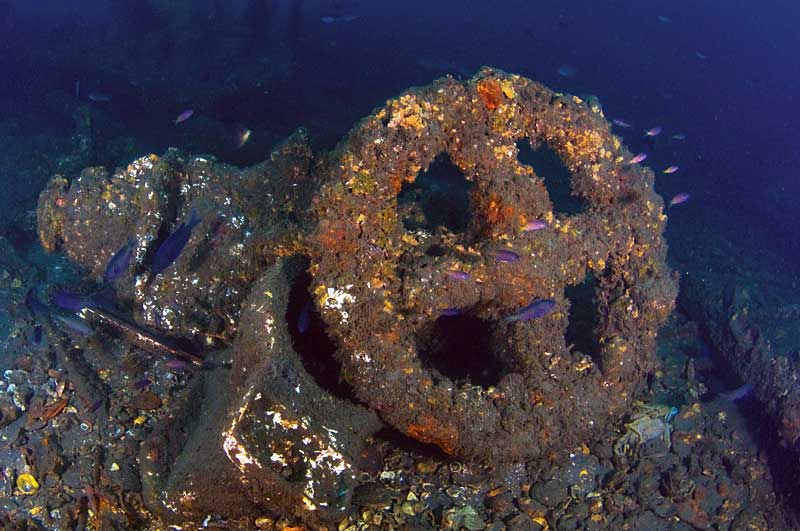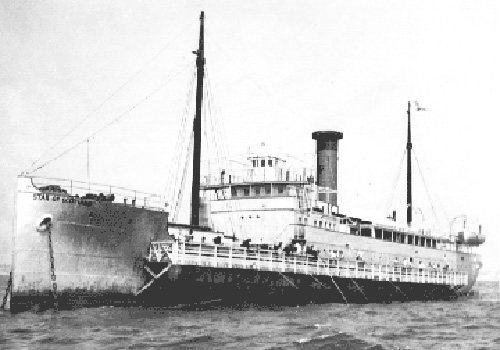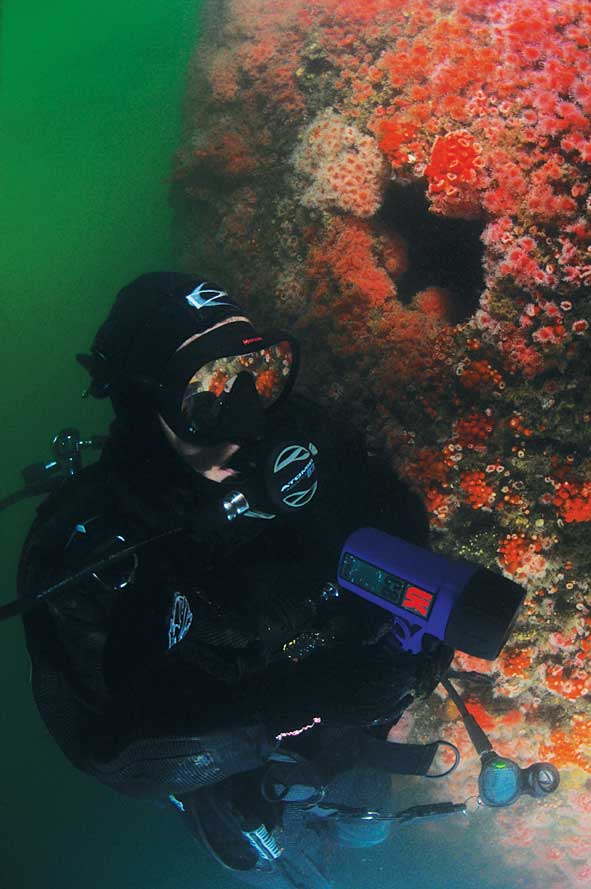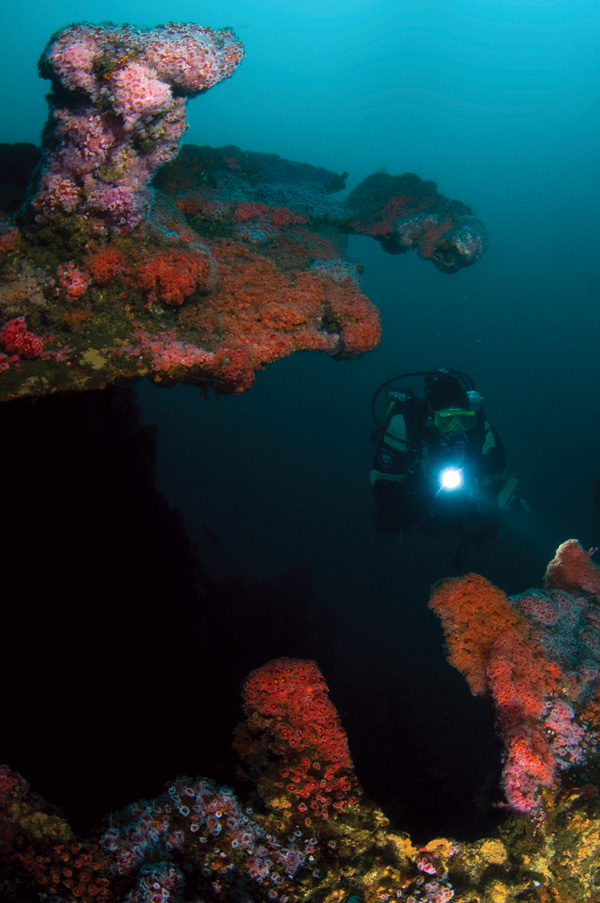There is an intriguing allure about man-made “things” underwater. Whether it is an old, barnacle-encrusted coffee mug or a gold bar from a Spanish galleon, the mystery and question of “how did this get here” jumps into our mind whenever man-things on the bottom catch our attention. Of such items lost in the sea, there is perhaps no greater lure for divers than a shipwreck. But many times the questions who, what, when and how a wreck came to be are never known and after a brief (or thorough) examination by the visiting diver, the wreck just becomes “that pile on the bottom”. This is too bad and a great loss for divers, as the history associated with most shipwrecks is exciting and turns the dive from a visit to a “pile on the bottom” to a trip back in history. For southern California divers, one of the best wrecks to take that trip back in history is the Star of Scotland.
Words and photos by Patrick Smith
Located just a short distance off Santa Monica Pier, the Star began her life as a Royal Navy (British) warship. Launched as H.M.S. Mistletoe in 1917, the vessel was classed as a Flower Class Sloop and cruised the English Channel as innocent appearing “bait” for German U-boats. Built to look like an innocent merchant ship, she carried massive firepower hidden behind fold-down structures on her deck and her hold was packed with wood and other buoyant material to keep her afloat if her disguise was blown and she took a German torpedo. In the course of her naval career, she encountered German subs on two occasions; in one case both Mistletoe and the U-boat survived. In the second case, Mistletoe emerged the victor putting the enemy sub down for the final dive.
After the war, the Mistletoe was sold surplus and joined the commercial maritime world carrying cargo and freight along the Pacific Coast between Panama and San Francisco under her new name, Chiapas. Sold a few years later, her name was changed to La Playa de Ensenada and she carried fruit between the US and Mexico. A decline in world trade in the 1920s forced many ships into scrap yards. La Playa de Ensenada avoided that fate. She was sold, and with a new name – La Playa – moved into a new trade of drinks, dolls and dice as a gambling ship off Mexico. In 1933 she appeared off the southern California coast in the same line of work but with yet another new name. As the City of Panama she began running nightly “Cruises to Nowhere”, where for several hours optimistic passengers could experience various exotic entertainments or would try to beat the odds at the gaming tables, typically returning to port lighter in the wallet while providing a lucrative income for the ship’s owners. A murder on board shut the ship down, but she was brought back into Santa Monica Bay under the name Star of Hollywood, and continued to operate as before. In the late 1930’s, she was consigned to the backwaters of San Pedro for a while, but then again sold and renamed. As Texas, her penultimate name, she was setup as one of the four remaining gambling ships operating off California. On August 1, 1939, the state attorney general’s office raided these ships, and closed down offshore gambling for good.
Less than a year later, re-named Star of Scotland, she was back off the coast, operating as a party ship and fishing barge off Santa Monica. For the next couple of years she provided great fishing and romantic dining and dancing just two miles off Santa Monica Pier. But by January 1942, the Star was in desperate need of repair. Years of shore boats pounding against her hull as they moved passengers back and forth plus a quarter of a century at sea had caused her plates to separate, and the Star leaked like a sieve. With the attack on Pearl Harbor just 6-weeks earlier, there were no shipyards available to repair a leaky fishing barge, so the Star’s owners placed more pumps aboard to keep ahead in the race against the incoming waters.
On January 23, 1942, a violent storm struck the LA area and the winds and waves that struck the area were the final straw for the Star of Scotland. Just before 4:00 AM, the old warship lost her race against the Pacific and was forced to the bottom, taking one of her crew of five with her in final plunge. The next morning, just the tips of her masts remained above the surface, marking the Star’s final resting place.
Today, the Star is the première dive site in Santa Monica Bay. Since she is the only hard structure for some distance, she has become an underwater oasis. Her soggy hull is covered in invertebrate life with vast areas carpeted in Corynactus of every hue. The variety of fish found on the Star is absolutely amazing. Over the years of visiting the site nearly every type of sport fish has been seen on the wreck. Commonly found inhabitants include the resident barred sand bass, calico bass, sculpin, ling cod and cabezon. During the summer months typically found piscatorial visitors can include barracuda, Bonita, yellowtail, and mackerel – both greenback and Spanish. But other less common visitors such as blue fin tuna, sierra, the occasional wolf eel and white sharks (small ones) have visited as well. In the last few years, the Star has maintained a local population of giant sea bass, with one regular resident (Big Mama) that estimates place in the 300-plus pound range. During the warmer months, the population of these magnificent fish increases. On one recent dive, my buddy and I were surrounded by at least 17 of the creatures!
For macro photographers, there are few more interesting southern California sites to be found. The density and diversity of the life and photo subjects to be found on the Star could engage an underwater photographer for a lifetime. For the wide-angle photographer it becomes a bit more problematic. One of the drawbacks to the Star is her close proximity to land. This often creates visibility issues on the site with 10-15 foot being average, 30-40 foot not uncommon during Santana conditions, and 70-plus foot a rare and wonderful experience that typically happens perhaps twice a year. Divers I’ve brought to the Star who usually dive Catalina were torn when first diving her; she didn’t have the kelp or clarity of Catalina’s waters, but the myriad life on the wreck just blew them away. And then of course, there is the history.
Since the Star is such a fish haven, she has over the years accumulated substantial amounts of fishing gear and line. A keen-edged cutting tool (or two) is de rigueur, as is awareness of where one places his or her hands; fishing lures, fish hooks and sharp edges of rusting steel plates can do some damage and ruin a dive for the inattentive diver.
Despite the fact the Star is only a few miles from Marina del Rey, she doesn’t get visited as often as one would think, but that’s okay. If you make the effort and get out to the site on one of those clear water days and encounter a huge, swirling, silvery school of mackerel hovering over the Star’s majestic bow, and a half-dozen giant sea bass of various sizes floating about like aquatic Goodyear blimps, you’ll know why I have done nearly 300 dives to this site and can’t wait for the next opportunity to dive that historic pile of steel plates on the bottom of Santa Monica Bay called the Star of Scotland.




